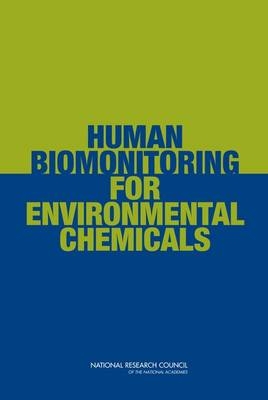
Human Biomonitoring for Environmental Chemicals
Seiten
2006
National Academies Press (Verlag)
978-0-309-10272-8 (ISBN)
National Academies Press (Verlag)
978-0-309-10272-8 (ISBN)
Biomonitoring - a method for measuring amounts of toxic chemicals in human tissues is a tool for studying harmful environmental chemicals. This book provides a framework for improving the use of biomonitoring data including developing and using biomarkers (measures of exposure), research to improve the interpretation of data, and more.
Biomonitoring—a method for measuring amounts of toxic chemicals in human tissues—is a valuable tool for studying potentially harmful environmental chemicals. Biomonitoring data have been used to confirm exposures to chemicals and validate public health policies. For example, population biomonitoring data showing high blood lead concentrations resulted in the U.S. Environmental Protection Agency's (EPA's) regulatory reduction of lead in gasoline; biomonitoring data confirmed a resultant drop in blood lead concentrations. Despite recent advances, the science needed to understand the implications of the biomonitoring data for human health is still in its nascent stages. Use of the data also raises communication and ethical challenges. In response to a congressional request, EPA asked the National Research Council to address those challenges in an independent study. Human Biomonitoring for Environmental Chemicals provides a framework for improving the use of biomonitoring data including developing and using biomarkers (measures of exposure), research to improve the interpretation of data, ways to communicate findings to the public, and a review of ethical issues.Table of Contents
Front Matter
Summary
1 Introduction
2 U.S. and International Biomonitoring Efforts
3 Framework to Characterize Biomarkers and Uses of Biomonitoring
4 Considerations in the Design of Biomonitoring Studies
5 Interpretation of Biomonitoring Results
6 Communicating Results, Interpretations, and Uses of Biomonitoring Data to Nonscientists
7 Research Agenda
Appendix A Biographic Information on the Committee on Human Biomonitoring for Environmental Toxicants
Appendix B Additional Case Studies Used to Exemplify Interpretative Approaches Described in Chapter 5
Appendix C PBPK Modeling
Glossary
Biomonitoring—a method for measuring amounts of toxic chemicals in human tissues—is a valuable tool for studying potentially harmful environmental chemicals. Biomonitoring data have been used to confirm exposures to chemicals and validate public health policies. For example, population biomonitoring data showing high blood lead concentrations resulted in the U.S. Environmental Protection Agency's (EPA's) regulatory reduction of lead in gasoline; biomonitoring data confirmed a resultant drop in blood lead concentrations. Despite recent advances, the science needed to understand the implications of the biomonitoring data for human health is still in its nascent stages. Use of the data also raises communication and ethical challenges. In response to a congressional request, EPA asked the National Research Council to address those challenges in an independent study. Human Biomonitoring for Environmental Chemicals provides a framework for improving the use of biomonitoring data including developing and using biomarkers (measures of exposure), research to improve the interpretation of data, ways to communicate findings to the public, and a review of ethical issues.Table of Contents
Front Matter
Summary
1 Introduction
2 U.S. and International Biomonitoring Efforts
3 Framework to Characterize Biomarkers and Uses of Biomonitoring
4 Considerations in the Design of Biomonitoring Studies
5 Interpretation of Biomonitoring Results
6 Communicating Results, Interpretations, and Uses of Biomonitoring Data to Nonscientists
7 Research Agenda
Appendix A Biographic Information on the Committee on Human Biomonitoring for Environmental Toxicants
Appendix B Additional Case Studies Used to Exemplify Interpretative Approaches Described in Chapter 5
Appendix C PBPK Modeling
Glossary
Committee on Human Biomonitoring for Environmental Toxicants, National Research Council
1 Front Matter; 2 Summary; 3 1 Introduction; 4 2 U.S. and International Biomonitoring Efforts; 5 3 Framework to Characterize Biomarkers and Uses of Biomonitoring; 6 4 Considerations in the Design of Biomonitoring Studies; 7 5 Interpretation of Biomonitoring Results; 8 6 Communicating Results, Interpretations, and Uses of Biomonitoring Data to Nonscientists; 9 7 Research Agenda; 10 Appendix A Biographic Information on the Committee on Human Biomonitoring for Environmental Toxicants; 11 Appendix B Additional Case Studies Used to Exemplify Interpretative Approaches Described in Chapter 5; 12 Appendix C PBPK Modeling; 13 Glossary
| Erscheint lt. Verlag | 30.11.2006 |
|---|---|
| Verlagsort | Washington |
| Sprache | englisch |
| Maße | 152 x 229 mm |
| Themenwelt | Studium ► 2. Studienabschnitt (Klinik) ► Pharmakologie / Toxikologie |
| ISBN-10 | 0-309-10272-3 / 0309102723 |
| ISBN-13 | 978-0-309-10272-8 / 9780309102728 |
| Zustand | Neuware |
| Haben Sie eine Frage zum Produkt? |
Mehr entdecken
aus dem Bereich
aus dem Bereich
Buch | Hardcover (2024)
Thomas Karow (Verlag)
57,80 €
Buch | Hardcover (2022)
Urban & Fischer in Elsevier (Verlag)
99,00 €


